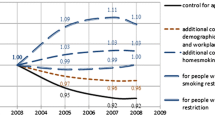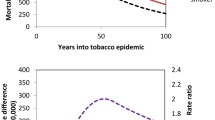Abstract
Los Angeles County has among the lowest smoking rates of large urban counties in the USA. Nevertheless, concerning disparities persist as high smoking prevalence is found among certain subgroups. We calculated adult smoking prevalence in the incorporated cities of Los Angeles County in order to identify cities with high smoking prevalence. The prevalence was estimated by a model-based small area estimation method with utilization of three data sources, including the 2007 Los Angeles County Health Survey, the 2000 Census, and the 2007 Los Angeles County Population Estimates and Projection System. Smoking prevalence varied considerably across cities, with a more than fourfold difference between the lowest (5.3%) and the highest prevalence (21.7%). Higher smoking prevalence was generally found in socioeconomically disadvantaged cities. The disparities identified here add another layer of data to our knowledge of the health inequities experienced by low-income urban communities and provide much sought data for local tobacco control. Our study also demonstrates the feasibility of providing credible local estimates of smoking prevalence using the model-based small area estimation method.

Similar content being viewed by others
Notes
LA County has 26 HDs and 8 SPAs. Each SPA consists of 1–5 HDs. HDs and SPAs have coincident boundaries.
References
Los Angeles County Department of Public Health. Cigarette Smoking in Los Angeles County: Local Data to Inform Tobacco Policy. Los Angeles, CA: Los Angeles County Department of Public Health, Office of Health Assessment and Epidemiology; June 2010.
Los Angeles County Department of Public Health. LA Health Trends: Cigarette Smoking among Los Angeles County Adults. Los Angeles, CA: Los Angeles County Department of Public Health, Office of Health Assessment and Epidemiology; 2006.
Warner KE, Mendez D, Alshanqeety O. Tobacco control success versus demographic destiny: examining the causes of the low smoking prevalence in California. Am J Public Health. 2008; 98(2): 268–9.
Simon PA, Wold CM, Cousineau MR, Fielding JE. Meeting the data needs of a local health department: the Los Angeles County Health Survey. Am J Public Health. 2001; 91(12): 1950–2.
Yu H, Meng YY, Mendez-Luck CA, Jhawar M, Wallace SP. Small-area estimation of health insurance coverage for California legislative districts. Am J Public Health. 2007; 97(4): 731–7.
Mendez-Luck CA, Yu H, Meng YY, Jhawar M, Wallace SP. Estimating health conditions for small areas: asthma symptom prevalence for state legislative districts. Health Serv Res. 2007; 42(6 Pt 2): 2389–409.
Standard Definitions: Final Dispositions of Case Codes and Outcome Rates for Surveys. 5th ed. Lenexa, KS: AAPOR: The American Association for Public Opinion Research; 2008.
County of Los Angeles. Estimated Census Tract-City Split Population by Age, Sex, and Race/Ethnicity. Los Angeles, CA: County of Los Angeles, Chief Executive Office, Service Integration Branch; 2008.
Hosmer DW, Lemeshow S. Confidence interval estimates of an index of quality performance based on logistic regression models. Stat Med. 1995; 14(19): 2161–72.
Cohen RA, Bloom B. Trends in Health Insurance and Access to Medical Care for Children under Age 19 Years: United States, 1998–2003. Advance data from Vital and Health Statistics. Hyattsville, MD: National Center for Health Statistics; 2005.
Lewis LB, Sloane DC, Nascimento LM, et al. African Americans’ access to healthy food options in South Los Angeles restaurants. Am J Public Health. 2005; 95(4): 668–73.
Kipke MD, Iverson E, Moore D, et al. Food and park environments: neighborhood-level risks for childhood obesity in East Los Angeles. J Adolesc Health. 2007; 40(4): 325–33.
Simon PA, Kwan D, Angelescu A, Shih M, Fielding JE. Proximity of fast food restaurants to schools: do neighborhood income and type of school matter? Prev Med. 2008; 47(3): 284–8.
Sloane DC, Diamant AL, Lewis LB, et al. Improving the nutritional resource environment for healthy living through community-based participatory research. J Gen Intern Med. 2003; 18(7): 568–75.
Jetter KM, Cassady DL. The availability and cost of healthier food alternatives. Am J Prev Med. 2006; 30(1): 38–44.
Smoking-attributable mortality, years of potential life lost, and productivity losses—United States, 2000–2004. MMWR Morb Mortal Wkly Rep. 2008; 57(45): 1226–1228.
Goodman MS. Comparison of small-area analysis techniques for estimating prevalence by race. Prev Chronic Dis. 2010; 7(2): A33.
Jia H, Muennig P, Borawski E. Comparison of small-area analysis techniques for estimating county-level outcomes. Am J Prev Med. 2004; 26(5): 453–60.
Malec D, Davis WW, Cao X. Model-based small area estimates of overweight prevalence using sample selection adjustment. Stat Med. 1999; 18(23): 3189–200.
Li W, Kelsey JL, Zhang Z, et al. Small-area estimation and prioritizing communities for obesity control in Massachusetts. Am J Public Health. 2009; 99(3): 511–9.
Li W, Land T, Zhang Z, Keithly L, Kelsey JL. Small-area estimation and prioritizing communities for tobacco control efforts in Massachusetts. Am J Public Health. 2009; 99(3): 470–9.
Knutson K, Zhang W, Tabnak F. Applying the small-area estimation method to estimate a population eligible for breast cancer detection services. Prev Chronic Dis. 2008; 5(1): A10.
Twigg L, Moon G. Predicting small area health-related behaviour: a comparison of multilevel synthetic estimation and local survey data. Soc Sci Med. 2002; 54(6): 931–7.
Twigg L, Moon G, Jones K. Predicting small-area health-related behaviour: a comparison of smoking and drinking indicators. Soc Sci Med. 2000; 50(7–8): 1109–20.
Blumberg SJ, Luke JV. Wireless Substitution: Early Release of Estimates from the National Health Interview Survey, July–December 2009. Hyattsville, MD: Division of Health Interview Statistics, National Center for Health Statistics; 2010.
Keeter S, Kennedy C, Dimock M, Best J, Graighill P. Gauging the impact of growing nonresponse on estimates from a national RDD telephone survey. Public Opin Q. 2006; 70(5): 759–79.
Keeter S, Miller C, Kohut A, Groves RM, Presser S. Consequences of reducing nonresponse in a national telephone survey. Public Opin Q. 2000; 64(2): 125–48.
Murray RP, Connett JE, Istvan JA, Nides MA, Rempel-Rossum S. Relations of cotinine and carbon monoxide to self-reported smoking in a cohort of smokers and ex-smokers followed over 5 years. Nicotine Tob Res. 2002; 4(3): 287–94.
Pell JP, Haw SJ, Cobbe SM, et al. Validity of self-reported smoking status: comparison of patients admitted to hospital with acute coronary syndrome and the general population. Nicotine Tob Res. 2008; 10(5): 861–6.
Acknowledgments
We thank Yajun Du for helping with the 2000 Census data, Aida Angelescu and Alex Ho for helping with PEPS data and creating the map, and as Linda Aragon and Mark Weber for providing expertise on local tobacco control efforts. We are also indebted to the staff of the Health Assessment Unit for their ongoing work on the LACHS, and to Paul Simon who provided guidance on the project.
Author information
Authors and Affiliations
Corresponding author
Electronic supplementary material
Below is the link to the electronic supplementary material.
ESM 1
(DOC 94 kb)
Rights and permissions
About this article
Cite this article
Cui, Y., Baldwin, S.B., Lightstone, A.S. et al. Small Area Estimates Reveal High Cigarette Smoking Prevalence in Low-Income Cities of Los Angeles County. J Urban Health 89, 397–406 (2012). https://doi.org/10.1007/s11524-011-9615-0
Published:
Issue Date:
DOI: https://doi.org/10.1007/s11524-011-9615-0




